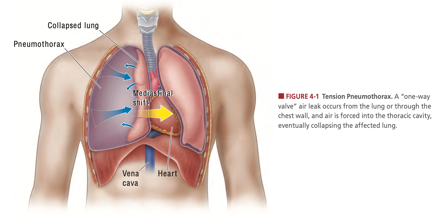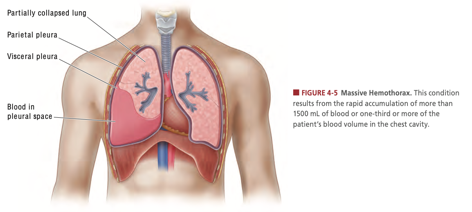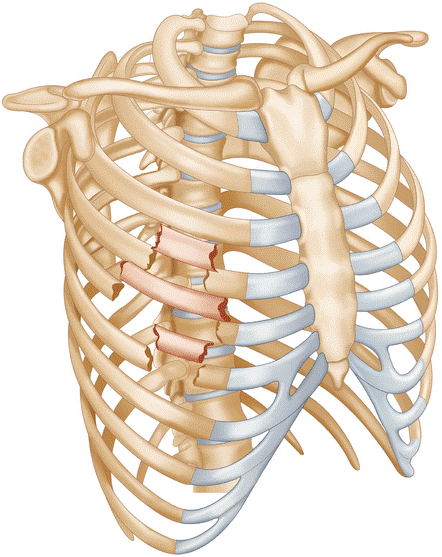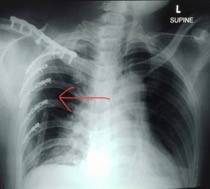
The thorax is the chest cavity, which consists of bones, muscles, great blood vessels and internal organs such as the lungs and heart. Thoracic trauma is the second most common type of trauma and has a very high mortality. Thoracic trauma can be caused by blunt trauma or sharp trauma. Trauma to the thorax can cause a pneumothorax, hemothorax or rib fractures.
Pneumothorax is a collection of air in the pleural space. Pleura is a thin layer that lines the lungs. Under normal circumstances, there is only a small amount of fluid in the pleural space to lubricate the lungs. Pneumothorax can be caused by blunt, sharp trauma with or without an open wound to the chest wall. Pneumothorax is an emergency that can cause death. Air trapped in the pleural cavity can press on the lungs, causing the lungs to collapse and it becomes difficult to breathe. Trapped air if not released over time can put pressure on the heart and large blood vessels which can cause obstructive shock, in other words disrupting the blood pump so that blood flow to body tissues is reduced.

*Picture 1. Pneumothorax
Hemothorax is a collection of blood in the pleural space. Bleeding can occur due to lesions in the arteries of the chest wall, lesions in the lung tissue, or broken ribs. The symptoms of a hemothorax are similar to those of a pneumothorax. Blood trapped in the pleural cavity can press on the internal organs causing tightness, and ongoing bleeding can put the patient in a state of hemorrhagic shock/shock due to bleeding.

*Picture 2. Hemothorax
The treatment for pneumothorax and hemothorax is by installing a WSD (Water Sealed Drainage)/Chestube. WSD is an act of installing a tube/hose in the thoracic cavity that is connected to a bottle to remove air, blood or fluid. WSD installation is a minimally invasive procedure that is easy to do and can prevent the worsening of cases of pneumothorax or hemothorax.
Costae fractures or also known as rib fractures are also a case of trauma. The symptom of a rib fracture is pain. Rib fractures can also cause pneumothorax, hemothorax or laceration of lung tissue. Treatment of rib fractures is by internal fixation with plates and screws. The installation of plates and screws on rib fractures can accelerate healing and minimize pain arising from fractures.
In cases of rib fractures where plates and screws are not installed, healing will take longer and nothing will minimize the pain that appears every time you take a breath, as well as delays in productivity.


*Figure 3. Fracture of the Costae and Plate & Screw
Because the organs affected by this trauma are very important organs, namely the respiratory and circulatory functions, fast and appropriate treatment will result in better healing and improve quality of life.
Article written by dr. Marolop Pardede, Sp.BTKV(K), MH (Specialist in Thoracic, Cardiac and Vascular Surgery at EMC Cikarang & Pekayon Hospital).
